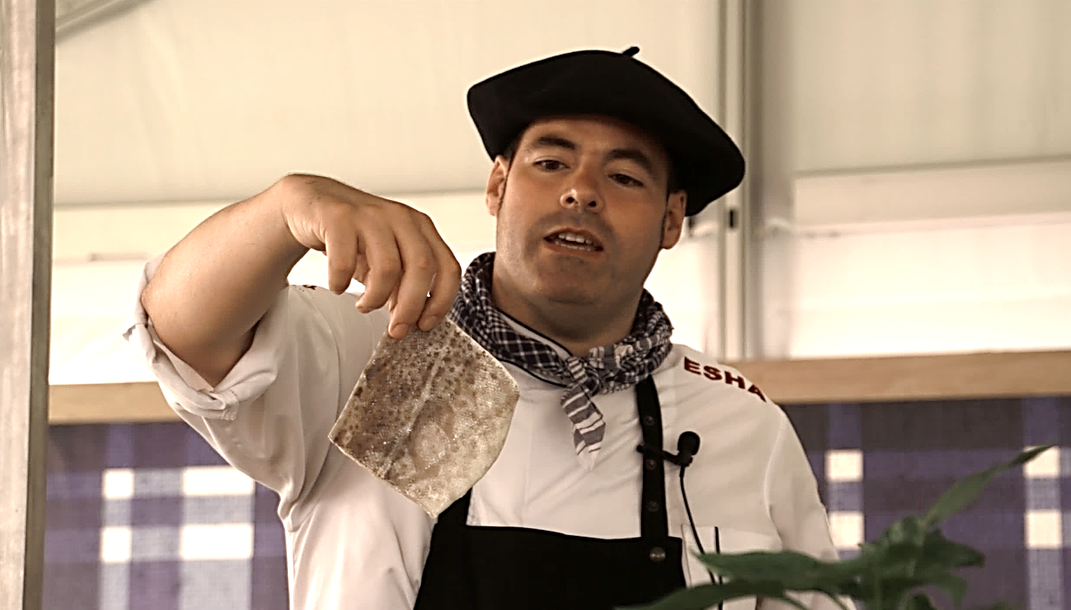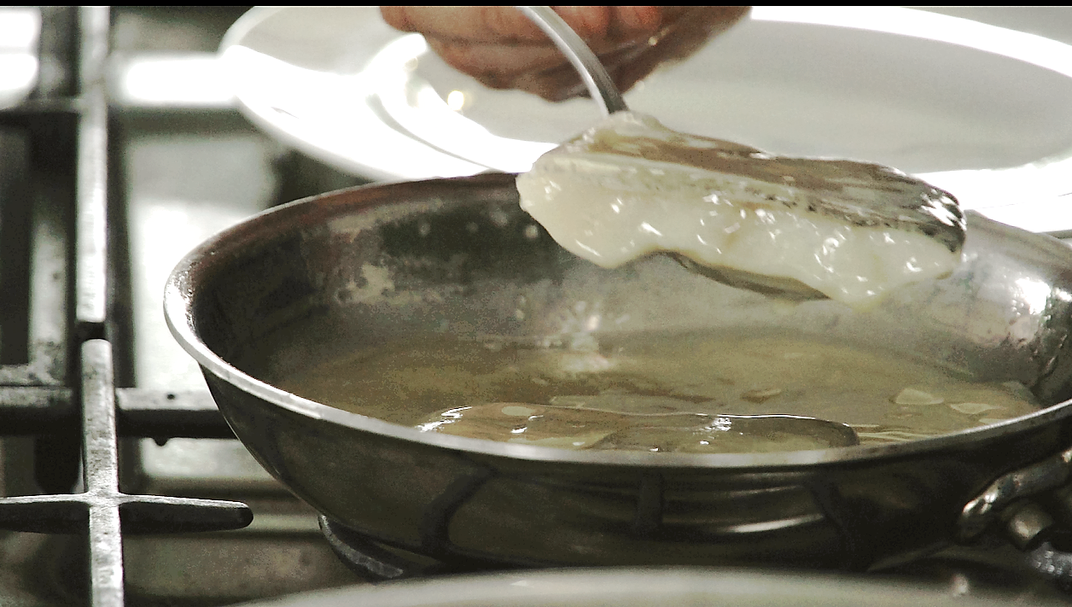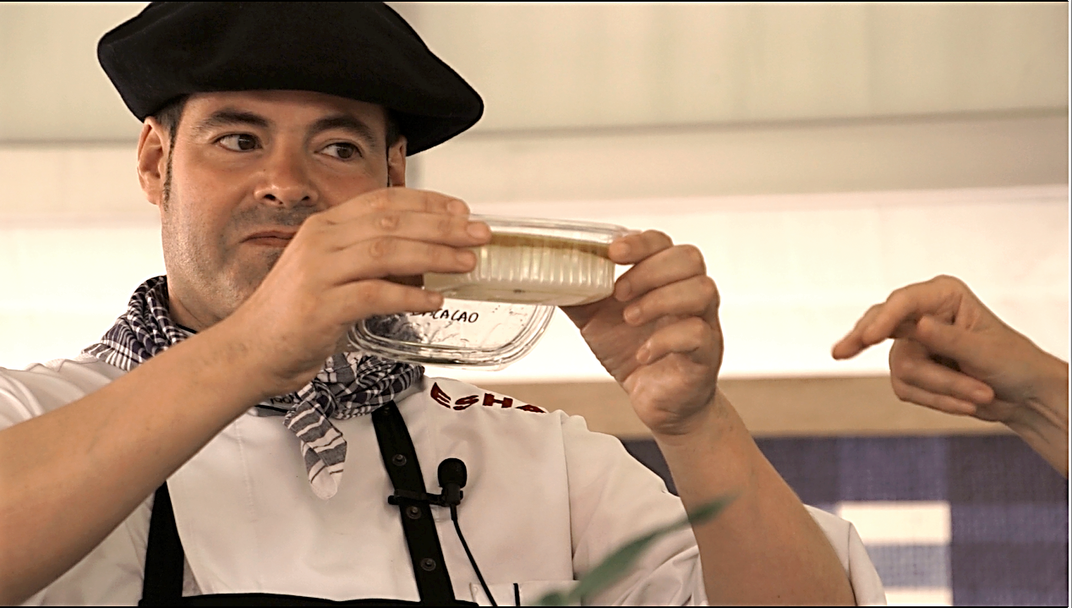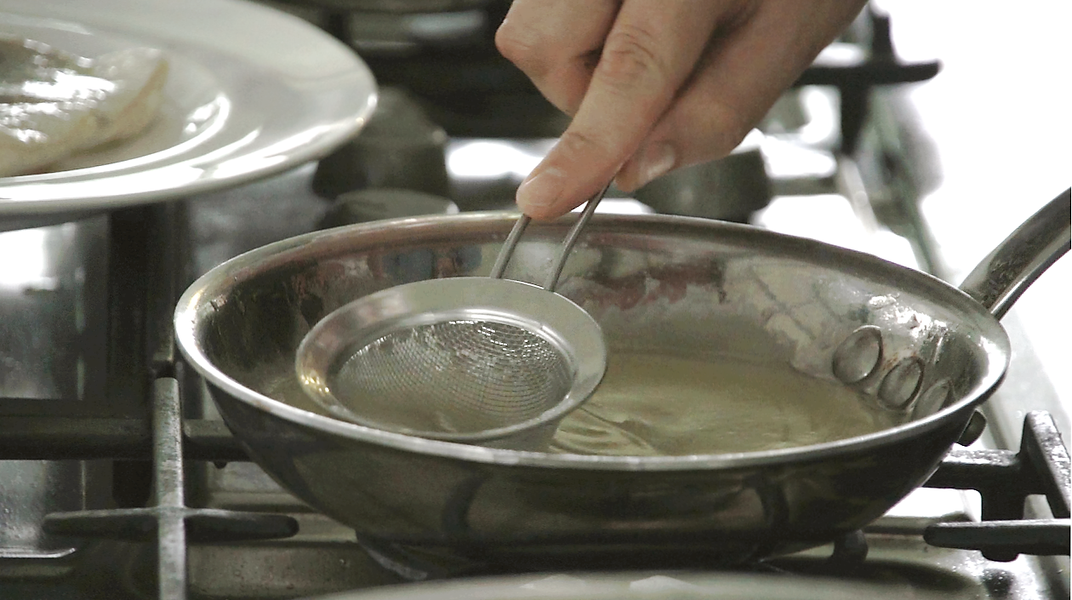Here’s an Ingeniously Simple Method for Making Bakailaoa Pil-pilean, the Traditional Basque Meal
Digesting the lessons that the Basque chefs taught at this summer’s Folklife Festival
/https://tf-cmsv2-smithsonianmag-media.s3.amazonaws.com/filer/a4/13/a4133d09-d34d-4788-a7af-d4893f7fe481/cod_1.png)
The Basque country’s salt cod dish, known as bakailaoa pil-pilean, is perhaps one of the most ancient of traditions, and has its origins in a deep maritime history that required the preservation of food for the long journey to distant fishing stocks. But today’s chefs are incorporating new ideas to prepare the creamy yellow-white sauce that is the hallmark of a dish that some say is finer and better tasting than even the freshest of cod pulled directly from the sea.
The recipe with just three ingredients—salt cod with skin, olive oil and garlic—is not easy to make. In the txokoak, or Basque gastronomy clubs, chefs compete to make the tastiest of bakailaoa pil-pilean.
The main ingredient salt cod with skin is difficult to find in the United States, but the sauce can’t be made without the natural gelatin found in its skin. This summer as chefs Igor Ozamiz Goiriena and Igor Cantabrana prepared for their journey to Washington D.C. for the Smithsonian Folklife Festival, which honored the music, craft and artisanal traditions of Basque Country on the National Mall in June and July, the pair found that the easiest way to assure that the main ingredient would be available for their cooking demonstrations was to pack 18 pounds of dried cod into their suitcases with their clothing.
The two chefs told us that the first thing we must do is to “eat with our eyes,” and the dishes they prepared at the Festival’s demonstration tent, the Ostatua Kitchen, were certainly a treat to see. Visitors were treated to a sensory experience of the sights, sounds, and smells of some of the world’s best cuisine; and the chefs shared their history and showed how Basque gastronomy is intimately tied to tradition and innovation. Bakailaoa pil-pilean, or cod in pil-pil sauce, is no exception.
Bakailaoa pil-pilean has a long history tied to Basque whaling expeditions of the 15th century. While there is no archeological evidence, it is possible that the Basques crossed the Atlantic even earlier, at least 100 years before Columbus. The Basque first embarked to distant ports in Greenland and Newfoundland, aided in their hunt for whales by sustaining themselves on the large schools of Atlantic cod, caught and salted to preserve aboard ship. Later as whales were overhunted and became scarce, cod fishing supplanted it, and whalers returned with their bounty to the Basque country to trade for salt and wine, and other goods.

The Basque were among the first people to preserve cod, using salt from the natural springs in the Añana valley, at a spring that is 300 times saltier than the ociean, where people have been producing salt for more than 6,000 years. This made the fish longer lasting and easier to trade.
As early as the 11th century, Basque salt cod was sold on an international market.
Chef Igor Ozamiz Goiriena recalled the rich personal stories of his grandfather, a captain of a cod ship that sailed to St. John’s, Newfoundland. His grandfather used to boast of so many cod in the sea that “you could walk on water.” His traditional recipe for bakailaoa pil-pilean came from his grandmother.
There is a science to the tradition of creating the Bakailaoa pil-pilean. The seemingly simple dish requires the emulsion of olive oil with the gelatin of the cod—two substances that are not normally soluble.

To make pil-pil sauce, Ozamiz Goiriena said that it needed the right balance of four things—water, fat, air and an emulsifying agent. With the perfect balance, a rich creamy, yellow-white sauce swirls to a perfection.
Atlantic cod is a cold-water fish, meaning its gelatin is high in both fat and amino acids. The gelatin easily provides the fat required to make pil-pil sauce while also serving doubly as an emulsifying agent. Gelatin works well as an emulsifier because it has elements that are both water soluble and fat soluble, allowing it to form a barrier between fat droplets and the liquid in which they are dispersed. The amino acids form a tangled net that traps fat droplets, further dispersing the fat and stabilizing the mixture. The olive oil brings in more fats and water.
With just gelatin, olive oil and air, the fish has all four main requirements for an emulsion. However, emulsions do not form on their own, as they are rather unstable. You need to give energy and air to the emulsion by shaking and stirring the gelatin as you mix in olive oil. This turns the fat into droplets that can then be trapped by the gelatin.
Chef Gorka Mota explained that in one Basque legend, pil-pil sauce was first created by the rocking motion of fishing ships at sea. Another legend suggests that the dish has roots in the First Carlist War: a merchant’s request for salt cod was misinterpreted by the telegraph operator, and he ended up ordering a million salt cod. It was a fortunate error, as Bilbao was soon under siege, and the only food available was salt cod, olive oil, garlic and dried pepper.

To survive, the people of Bilbao ate cod cooked in olive oil. By the end of the century, Basques discovered that if the cod was cooked in an earthen casserole dish and moved in a circular motion, the sauce would become creamy and white.
In his own cooking, Igor Ozamiz Goiriena uses a mesh colander to create pil-pil sauce, a technique he learned in culinary school.
Using the bottom of colander as a stirring tool, he slowly pours the olive oil through it and mixes it with the gelatin in the pan. This technique is highly effective at adding air and causing it to emulsify. The innovative use of the colander, he jokes, would have infuriated his grandmother. She did not know, as chefs do today, that pil-pil sauce is an emulsion. However, she knew from experience and tradition that if she rotated the pot in circles, the pil-pil sauce would become creamy.
These new techniques have been adopted by chefs as Basque cooking incorporates more knowledge from chemistry and other sciences into the ancient traditions.

Recipe: Bakailaoa pil-pilean (Cod in Pil-Pil Sauce)
Makes two servings
Ingredients
8 oz. (1 loin) salted and dried cod with the skin attached
1-2 cups extra virgin olive oil
3-4 garlic cloves
Instructions
1. Soak the dried salt cod in cold water for 48 hours to rehydrate. Change the water every 8 hours. Once done, cut into 2 even chunks about 2 inches wide.
2. In a 3-quart saucepan, add a layer of olive oil (~1/2 cup). Add 2 tablespoons of chopped garlic. Place the pot on low heat (~158 degrees Fahrenheit). Let the garlic perfume the oil for 2 to 3 minutes. Strain the oil to remove the garlic. Put the oil back in the pot.
Note: The olive oil should not change color. If it does, the heat is too high, and the garlic is frying.
3. Add the slices of cod to the pot. Add more olive oil to cover the fish (~1 cup). Keeping the heat low (158-176 degrees), bring the oil to a boil. Let the fish poach slowly so that it releases its gelatin. The gelatin will come out as bubbles, separate from the oil, and settle at the bottom of the pot.
Note: Place the fish cuts close to one another to conserve oil. You will use a lot of oil but it is needed to poach the fish. Make sure to keep the heat low or the gelatin will evaporate.
4. After poaching for around 20 minutes, remove the fish. It is done when the meat comes off in petals and has a white coloring.
5. Stir the remaining oil and gelatin in small circles to further separate. Pour out the oil and keep it for later.
6. Put the gelatin in a 10-inch sauté pan at room temperature. Stir the gelatin with the bottom of a mesh colander or tea strainer to solidify it. Using the colander, slowly add the oil back while continuing to stir the gelatin. Add oil until it becomes a thick sauce. It will be yellow-white and creamy.
7. Place the fish in the pan with the finished pil-pil sauce. On low heat, reheat the cod and pil-pil sauce. Use a spoon to baste the fish in the sauce for 1 to 2 minutes. Remove the fish, and place it in a serving dish. Stir the sauce a few times, and then add it to the serving dish so that it lightly covers the fish.
8. Optional: As a finish, add roasted garlic to the top of the fish.
Shanna Killeen is currently working on a master’s in English at Oregon State University. A version of this article was previously published on the Smithsonian Folklife Blog.